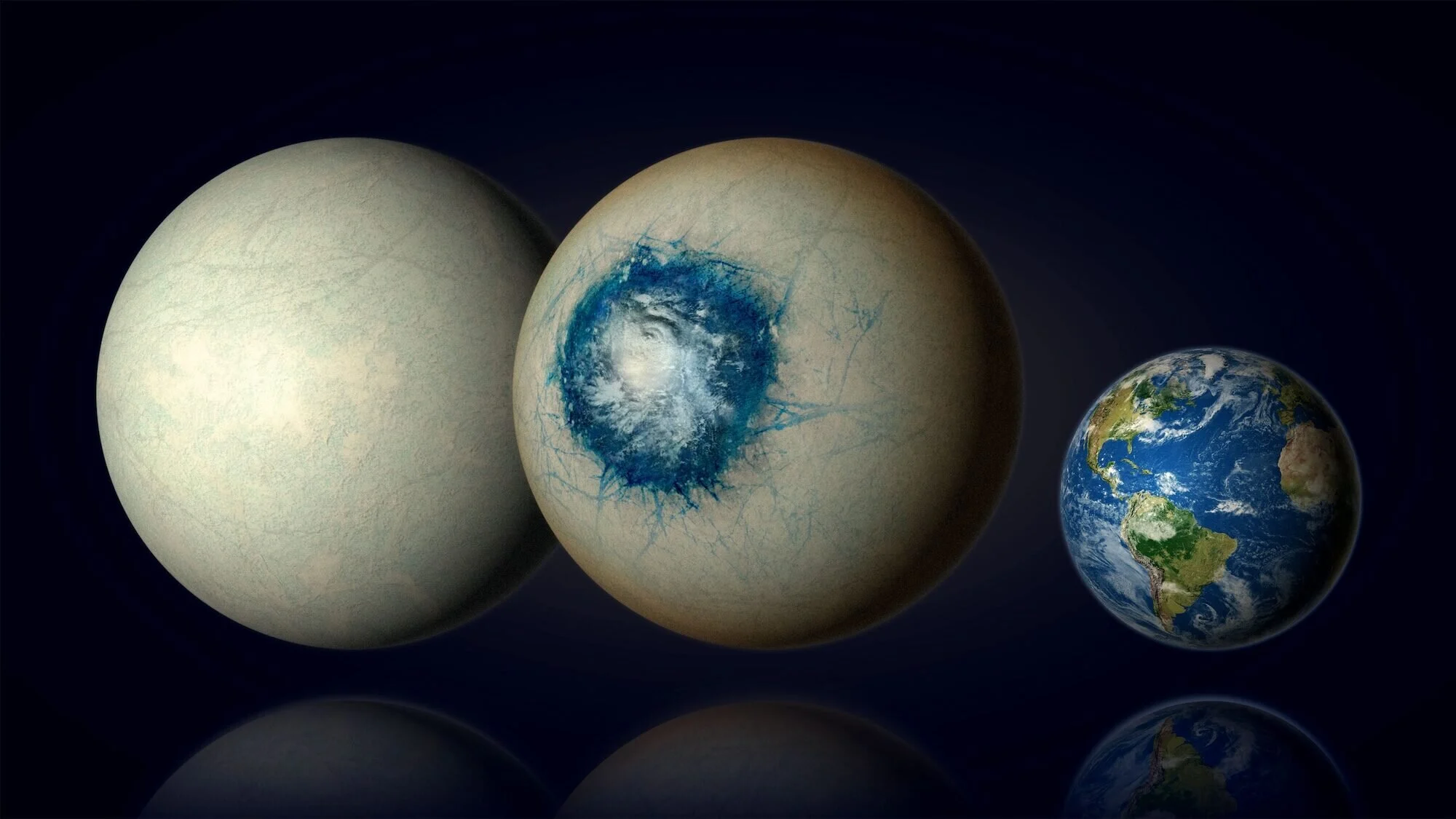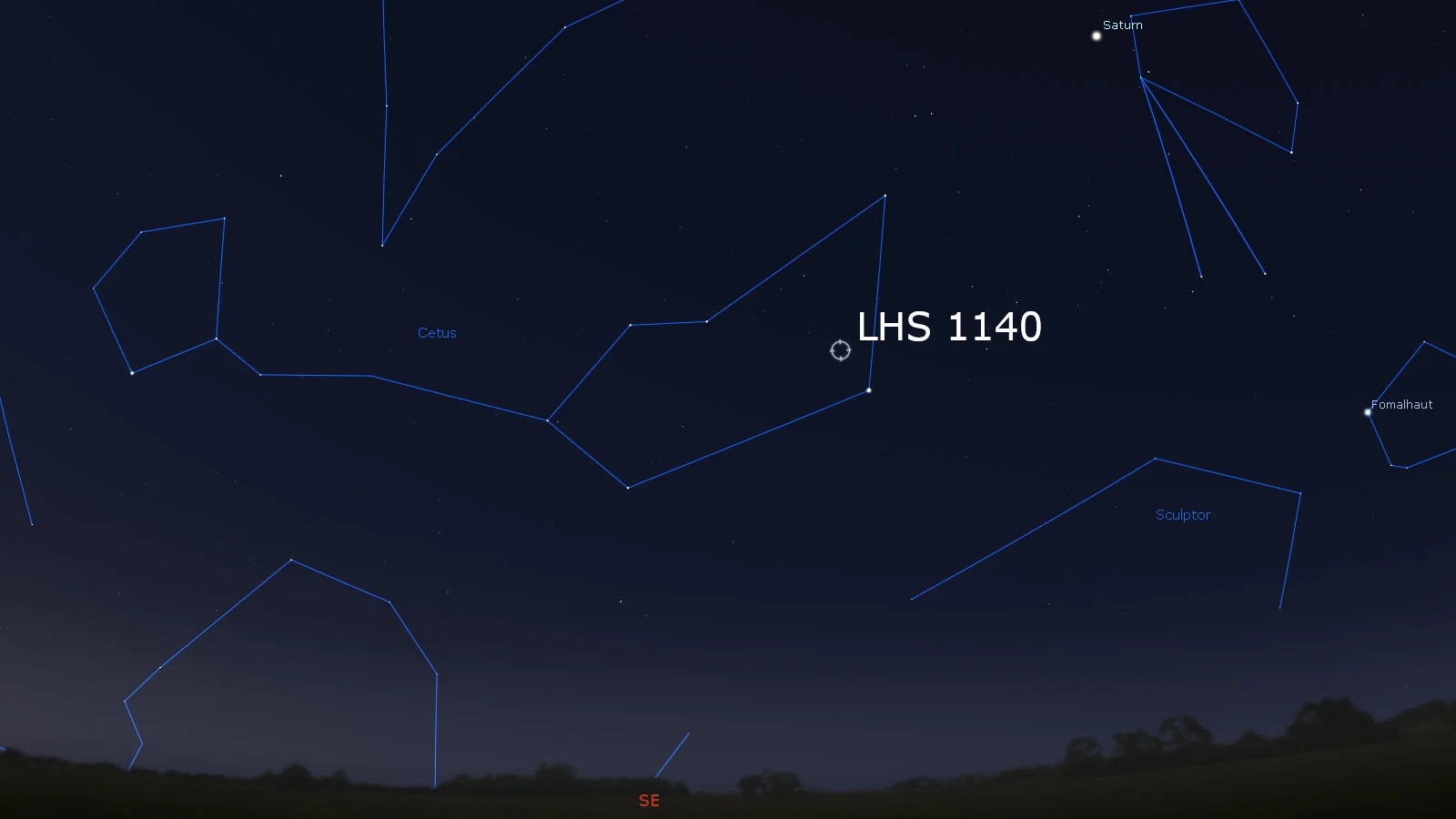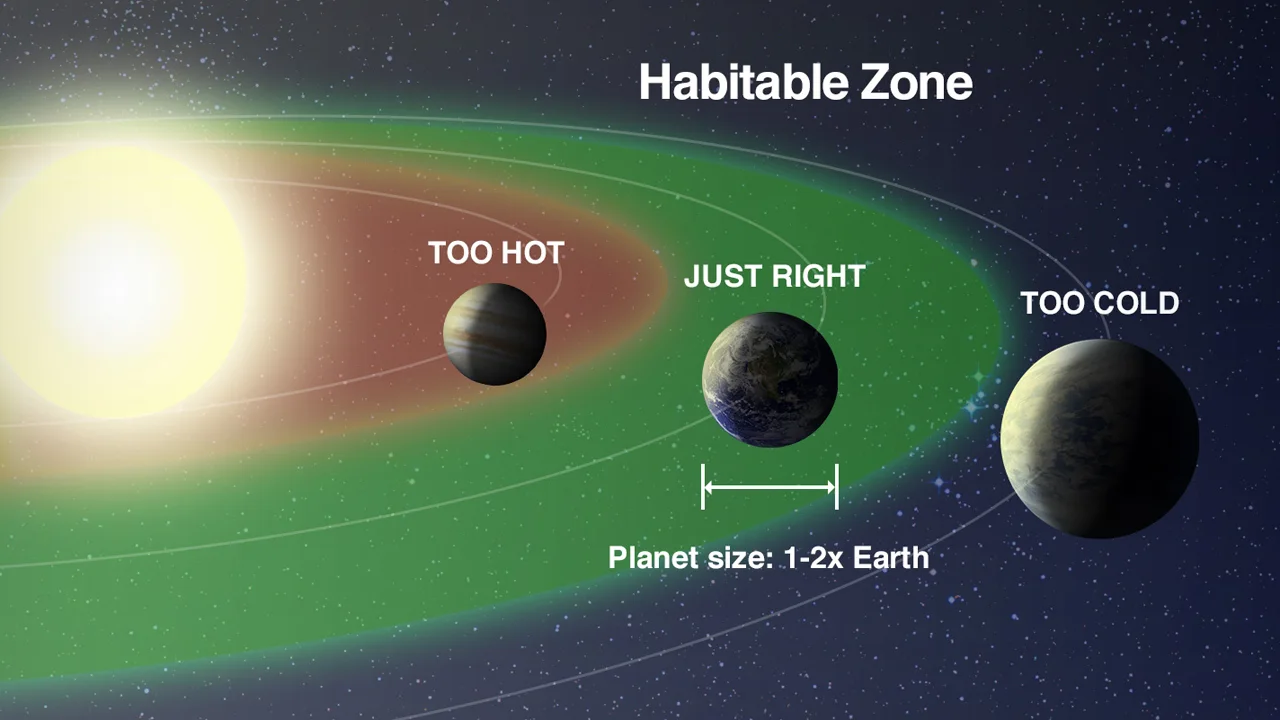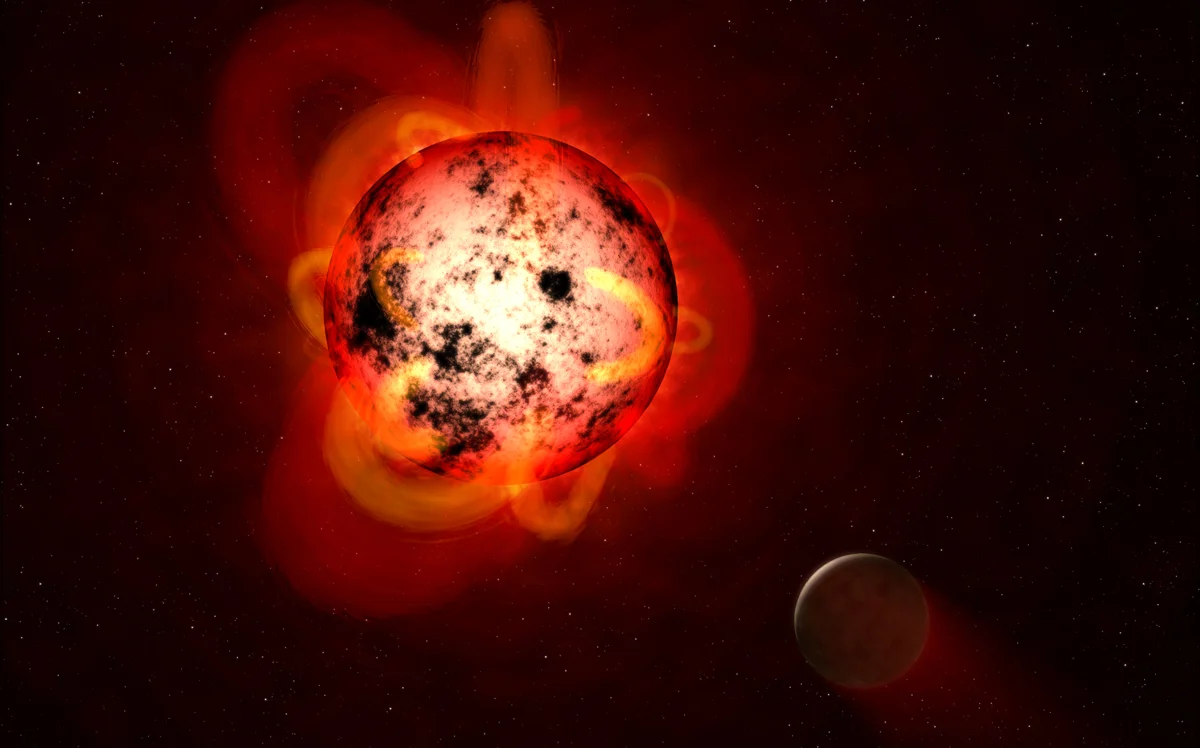
Icy super-Earth identified by Webb as 'promising' alien water world
This exoplanet may be the best place to look for signs of life beyond the Solar System.
Using the James Webb Space Telescope, a Canadian-led research team has discovered that a nearby exoplanet could be the best target we've found so far in the search for alien life.
Located around 48 light years away in the northern constellation Cetus ("the Whale") is a small red dwarf star named LHS 1140, which is only around one-fifth of the size and mass of our Sun. Currently, we know of two planets orbiting around that tiny star, each tidally locked to always have one face pointed directly at the star. The innermost of the two, named LHS 1140 c, takes just over three and a half days to orbit around the star, and is slightly larger and about twice the mass of Earth. The outermost of the two, LHS 1140 b, is far more interesting, though.

This simulation of the night sky shows LHS 1140 in the constellation Cetus, which is visible to the southeast in the predawn sky during northern summer. (Stellarium/Scott Sutherland)
LHS 1140 b is estimated to be around 70 per cent larger than Earth and roughly six times Earth's mass. Exoplanets of that size and mass tend to fall into one of two categories: gassy mini-Neptunes or rocky super-Earths.
The second option becomes an even more remarkable possibility when you take this exoplanet's orbit into consideration. LHS 1140 b orbits its star once every 25 days or so. In our own solar system, that would make it a scorching hot world, far closer to the Sun than Mercury. Around a small, cool red dwarf, though, that's a near-perfect location. In fact, it's right in the middle of LHS 1140's 'habitable zone', where temperatures on the planet's surface could be just right for liquid water to exist there.
"Of all currently known temperate exoplanets, LHS 1140 b could well be our best bet to one day indirectly confirm liquid water on the surface of an alien world beyond our Solar System," Charles Cadieux, the PhD student who led a new study of LHS 1140 b from the University of Montreal's Trottier Institute for Research on Exoplanets (iREx), said in a press release. "This would be a major milestone in the search for potentially habitable exoplanets."

Examples of three types of exoplanet are shown here, in relation to their potential habitability. Those too close to their star may have water but it would always be in hot vapour form, limiting their potential for life. Those too far away may also have water, but it would be locked up in ice, similar to Mars. Those exoplanets at just the right distance, though, could have liquid water oceans, raising their potential to host life. (NASA)
LHS 1140 b was discovered in 2017 by the MEarth Project, which uses special telescopes to watch nearby red dwarf stars for transits — a telltale dip in the star's brightness, due to an exoplanet passing in front of it. Follow up observations have been made with the High Accuracy Radial Velocity Planet Searcher (HARPS), NASA's Spitzer Space Telescope, the Echelle SPectrograph for Rocky Exoplanets and Stable Spectroscopic Observations (ESPRESSO), and NASA's Transiting Exoplanet Survey Satellite (TESS). These telescopes not only confirmed the planet was real, but also narrowed down its size and mass. Although nothing was confirmed, the Hubble Space Telescope may also have spied hints of water vapour in the planet's atmosphere.
In December of 2023, the James Webb Space Telescope took its turn. Aiming the NIRISS (Near-Infrared Imager and Slitless Spectrograph) instrument at LHS 1140, the telescope collected light from the star as LHS 1140 b passed in front of it on the 1st, and then again as both LHS 1140 b and LHS 1140 c crossed the star's face on the 26th.

The two transits, on December 1, 2023 and December 26, 2023, are shown here, revealing how the star's light decreased as the planets passed in between it and the Webb telescope's NIRISS instrument. The double-dip in the second observation shows the effect of both planets transiting at the same time. Below the main observations, the data is split into different wavelengths of infrared light. (Cadieux, et al. 2024/arVix)
Based on that data, Cadieux and a team of colleagues from Canada, the United States, France, and the United Kingdom determined that LHS 1140 b is far more likely to be a rocky super-Earth than a mini-Neptune.
Furthermore, their study found hints that this alien world may have an atmosphere rich in nitrogen.
If true, that would make it quite Earth-like! However, given that LHS 1140 b is a bit lighter than expected for a planet of its size, they estimate that somewhere between 10 and 20 per cent of the exoplanet's total mass might be contained in a global ocean covering its entire surface.
"Best place to look for signs of life beyond the Solar System."

This artist's impression shows the exoplanet LHS 1140 b, which orbits a red dwarf star 48 light-years from Earth and may be the new holder of the title "best place to look for signs of life beyond the Solar System." (ESO/spaceengine.org)
Due to the fact that LHS 1140 b receives only about 43 per cent of the amount of starlight that Earth gets from the Sun, the researchers figure there are two possibilities.
If LHS 1140 b has a thin hydrogen atmosphere above that global ocean, it could be be a planet completely encased in a solid crust of ice, similar to Jupiter's moon Europa.
However, if the exoplanet's atmosphere is a bit more like Earth's, with an abundance of nitrogen, along with other gases like carbon dioxide, it could be an icy 'eyeball' world. In that case, the atmosphere would retain enough heat to make it a 'balmy' 20°C at the equator, in the region pointed directly towards the star. While the rest of the planet would still be ice-covered, that would support a cloud-covered liquid water ocean, roughly half the size of the Atlantic Ocean.

On the left, two possible states for super-Earth LHS 1140 b are shown, one where the entire planet is encased in ice (possibly with a subsurface liquid ocean) and another where an ocean roughly half the size of the Atlantic Ocean could exist at the planet's equator, pointing directly towards the star. (Benoit Gougeon, University de Montreal)
"Detecting an Earth-like atmosphere on a temperate planet is pushing Webb's capabilities to its limits," study co-author Rene Doyon, who is the principal investigator of the Canadian-built NIRISS instrument, said.
"It's feasible," Doyon added. "We just need lots of observing time."
With LHS 1140 b transiting its star once every 25 days, that means there are around 14 potential observations each calendar year, each lasting about two hours. Due to Webb's limited field of view, though, as it must always point away from our Sun to keep its instruments cool, they can only get a maximum of eight observations of LHS 1140 b per year.
"The current hint of a nitrogen-rich atmosphere begs for confirmation with more data," Doyon explained. "We need at least one more year of observations to confirm that LHS 1140 b has an atmosphere, and likely two or three more to detect carbon dioxide."
A quiet star
Exoplanets around red dwarf stars are some of the easiest to find. The star's dim light makes it easier for telescopes to pick out the dips in brightness caused by a planetary transit. Also, the star's small size means that smaller planets produce bigger transits than they would for a larger star. This is especially important when looking for small rocky worlds that could be like Earth.
However, there's an important limitation for the potential habitability of these exoplanets.
Most red dwarf stars spin very quickly, only taking a few days to make a full rotation. This causes them to be very volatile, and they can produce frequent powerful flares and immense eruptions that could bathe their planets in levels of stellar radiation that would be lethal to anything trying to live there.

This artist's impression shows an active red dwarf star impacting its orbiting exoplanet. (NASA)
There's good news about LHS 1140 b, though.
Studies of its host star have shown that it rotates a lot slower than most. It takes roughly 130 days to spin on its axis, which is nearly 5 times slower than our own Sun's rotation!
Thus, LHS 1140 appears to be a very quiet star, with little to no flare activity. That would make it far 'kinder' to its planets, as well as to any life that may have evolved there.











